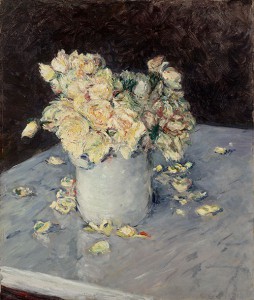
Yellow Roses in a Vase, 1882, Gustave Caillebotte (French, 1848–1894), oil on canvas, Dallas Museum of Art, The Eugene and Margaret McDermott Art Fund, Inc., in honor of Janet Kendall Forsythe, 2010.13.McD
This overblown bouquet of roses by Gustave Caillebotte features a cascade of petals, each one deftly built with just a few brushstrokes of thickly applied paint, scattered across a marble surface. Caillebotte’s choice of a marble tabletop, set against a scumbled, or thinly painted, black ground, may be an homage to Édouard Manet’s final series of floral still lifes.
However, the intensity of color at the center of the bouquet points to Caillebotte’s familiarity with the complex, densely worked surfaces of Claude Monet’s flower paintings. The reason that Caillebotte was so familiar with Monet’s style was because the two artists shared a Paris studio during 1882. In fact, Caillebotte purchased one of Monet’s floral still lifes.
Caillebotte kept his work Yellow Roses in a Vase throughout his life. At his postmortem sale, the painting was purchased by Edgar Degas, who also held onto the cherished painting until his death.
___________________________________________
This blog series delves into a selection of the works from the special exhibition Van Gogh, Manet, and Matisse: The Art of the Flower, which opens March 21. This exhibition traces the reinvention of the floral still life, as French artists in the 19th century turned this most traditional of genres into an unexpected field of experimentation and exploration. We hope that these posts will inspire you to enjoy this fascinating exhibition in person.